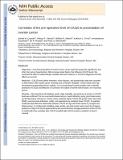| dc.contributor.author | Cramer, Daniel William | |
| dc.contributor.author | Vitonis, Allison F. | |
| dc.contributor.author | Welch, William Robert | |
| dc.contributor.author | Terry, Kathryn Lynne | |
| dc.contributor.author | Goodman, Annekathryn | |
| dc.contributor.author | Rueda, Bo Ruben | |
| dc.contributor.author | Berkowitz, Ross Stuart | |
| dc.date.accessioned | 2016-06-16T15:51:20Z | |
| dc.date.issued | 2010 | |
| dc.identifier.citation | Cramer, Daniel W., Allison F. Vitonis, William R. Welch, Kathryn L. Terry, Annekathryn Goodman, Bo R. Rueda, and Ross S. Berkowitz. 2010. “Correlates of the Preoperative Level of CA125 at Presentation of Ovarian Cancer.” Gynecologic Oncology 119 (3) (December): 462–468. doi:10.1016/j.ygyno.2010.08.028. | en_US |
| dc.identifier.issn | 0090-8258 | en_US |
| dc.identifier.uri | http://nrs.harvard.edu/urn-3:HUL.InstRepos:27332765 | |
| dc.description.abstract | Objective
CA125 at presentation of ovarian cancer carries important prognostic significance; but, other than tumor characteristics, little is known about factors that influence CA125 levels. We examined the effect of epidemiologic variables and tumor features on CA125 at diagnosis and their effects on survival.
Methods
CA125 levels before treatment, tumor features, and questionnaire data were recorded on 805 women with ovarian cancer receiving care at Partners Hospitals. CA125 values were log-normalized and generalized linear, logistic, or Cox proportional hazards models used to identify predictors of CA125 and influence on survival in the subset of women with invasive, non-mucinous tumors.
Results
The importance of histology, grade, stage, laterality, and presence of ascites on CA125 level was confirmed. For non-mucinous invasive cancers, Jewish ethnicity, parity, prior breast cancer, and family history of breast or ovarian cancer predicted higher CA125 and greater body mass index (BMI), recurrent yeast infections, colitis, and appendectomy predicted lower CA125. A quadratic model best described the relationship between CA125 and age with lower levels in youngest and oldest women. In multivariate modeling, stage, ascites, and prior breast cancer were the strongest predictors of high CA125 and appendectomy and yeast infections strongest predictors of low CA125. A model with these variables plus CA125 revealed high CA125 remains a predictor of poorer survival.
Conclusions
Ovarian tumor features and presence of ascites are key determinants of CA125 at diagnosis, but epidemiologic features such as BMI, parity, prior breast cancer, and history of inflammatory conditions of the genitourinary or gastrointestinal tracts may also play a role. | en_US |
| dc.language.iso | en_US | en_US |
| dc.publisher | Elsevier BV | en_US |
| dc.relation.isversionof | doi:10.1016/j.ygyno.2010.08.028 | en_US |
| dc.relation.hasversion | http://www.ncbi.nlm.nih.gov/pmc/articles/PMC2980911/ | en_US |
| dash.license | LAA | |
| dc.title | Correlates of the preoperative level of CA125 at presentation of ovarian cancer | en_US |
| dc.type | Journal Article | en_US |
| dc.description.version | Accepted Manuscript | en_US |
| dc.relation.journal | Gynecologic Oncology | en_US |
| dash.depositing.author | Cramer, Daniel William | |
| dc.date.available | 2016-06-16T15:51:20Z | |
| dc.identifier.doi | 10.1016/j.ygyno.2010.08.028 | * |
| dash.contributor.affiliated | Berkowitz, Ross | |
| dash.contributor.affiliated | Welch, William | |
| dash.contributor.affiliated | Rueda, Bo | |
| dash.contributor.affiliated | Goodman, Annekathryn | |
| dash.contributor.affiliated | Cramer, Daniel | |
| dash.contributor.affiliated | Terry, Kathryn | |


